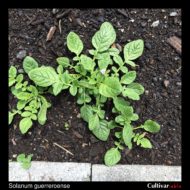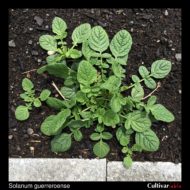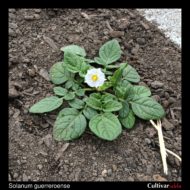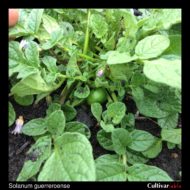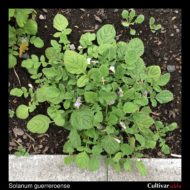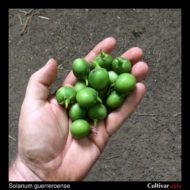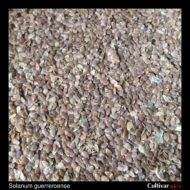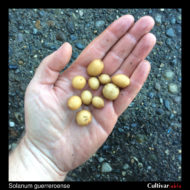Solanum guerreroense
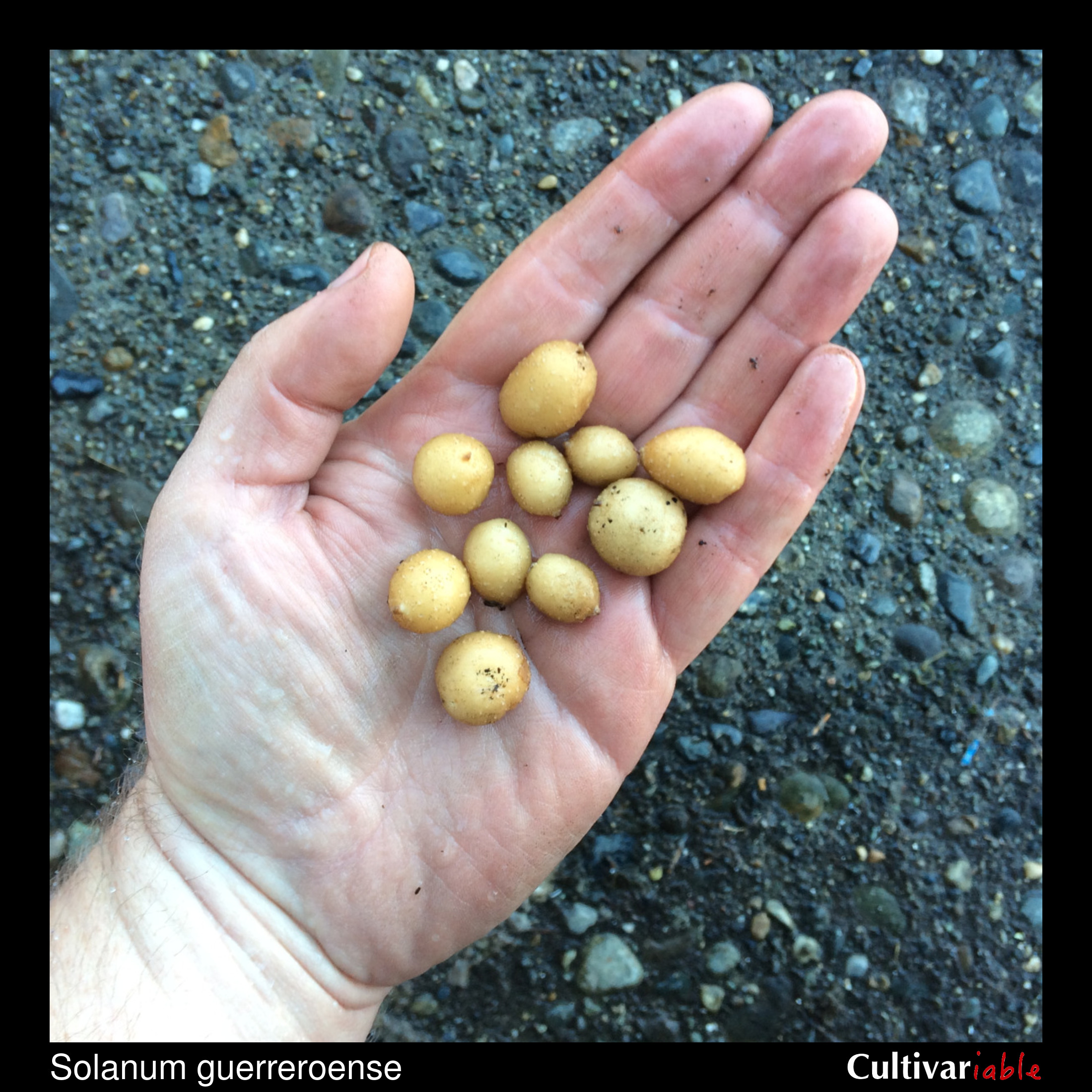
| Common Names | |
| Code | grr |
| Synonyms | |
| Clade | Mixed |
| Series | Demissa |
| Ploidy | Hexaploid (6x) |
| EBN | 4 |
| Tuberization Photoperiod | Short Day |
| Self-compatibility | Yes |
| Nuclear Genome | A |
| Cytoplasmic Genome | W, D |
| Citation | Correll: Agric. Monogr. U.S.D.A. 11: 65, figs. 43, 44. 1952. |
Description
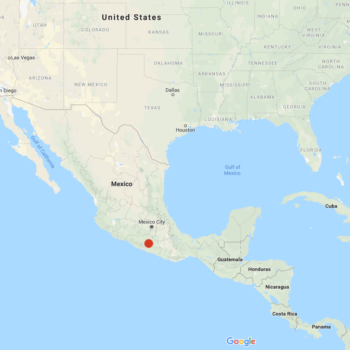
Solanum guerreroense is a species of very limited distribution in Guerrero, Mexico, where it grows in conifer and oak forests. It is only known from a single collection and expeditions since have failed to locate any plants (Spooner 2004). It may be synonymous with S. iopetalum (Marks 1965), although the plants that I have grown of each species do not look similar. Plants are low growing and can reach about nine inches tall. Violet flowers (although I have seen white with only a hint of purple). Tubers to about two inches, russet to purplish (Correll 1962). Berries are described in several sources as being conical, but I have only seen round berries.
The specific epithet, guerreroense, refers to Guerrero, Mexico. While there is no completely standardized pronunciation for scientific names, the most common way to pronounce this species is probably so-LAY-num gair-air-oh-EN-see.
Morphologically, this plant fits with a number of geographically separate rosette forming species, including South American species like S. acaule and S. albicans and North American species like S. demissum.
Watanabe (1994b) found that this species has disomic chromosome segregation, in common with most of the North American polyploid species.
1400 seeds per gram.
Resistances
Carlson-Nilsson (2010) found that the foliage of this species was very resistant to late blight, but the tubers only moderately resistant.
Zoteyeva (2014) found that this species carries the R3 late blight resistance gene, but also displays hypersensitive resistance when this gene is not present, indicating the presence of additional resistance factors.
Luthra (2007) found that this species is moderately resistant to frost damage, equal to the least frost resistant accessions of S. tuberosum subsp. andigenum.
Varieties derived from the breeding line PALB03016-3, which includes S. guerreroense genetics, have shown resistance to zebra chip (Rondon 2012). This probably indicates that this species carries resistance to the putative causal organism Liberibacter solanacearum.
| Condition | Type |
Level of Resistance | Source |
|---|---|---|---|
| Globodera rostochiensis (Potato Cyst/Golden Nematode) | Invertebrate | Not resistant | Castelli 2003 |
| Globodera rostochiensis (Potato Cyst/Golden Nematode) | Invertebrate | Not Resistant | Castelli 2003 |
| Liberibacter solanacearum (Zebra Chip) | Bacterium | Resistant | Rondon 2012 |
| Meloidogyne spp. (Root Knot Nematode) | Invertebrate | Not Resistant | Janssen 1995 |
| Myzus persicae (Green Peach Aphid) | Invertebrate | Somewhat Resistant | Radcliffe 1981 |
| Pectobacterium carotovorum (Blackleg/Soft Rot) | Bacterium | Somewhat Resistant | Lojkowska 1989 |
| Phytophthora infestans (Late Blight) | Fungus | Resistant | Black 1957, Douches 2001, Gavrilenko 2017 |
| Potato Leafroll Virus (PLRV) | Virus | Not Resistant | De Galarreta 1998 |
| Potato Spindle Tuber Viroid (PSTVd) | Virus | Somewhat Resistant | Sofy 2013, Machida-Hirano 2015 |
| Potato Virus M (PVM) | Virus | Not Resistant | De Galarreta 1998 |
| Potato Virus S (PVS) | Virus | Not Resistant | De Galarreta 1998 |
| Potato Virus X (PVX) | Virus | Somewhat Resistant | Turuleva 1990, Kiru 2008 |
| Potato Virus X (PVX) | Virus | Not Resistant | Zoteyeva 2012 |
| Potato Virus Y (PVY) | Virus | Somewhat Resistant | Turuleva 1990, Gavrilenko 2017 |
| Verticillium spp. (Verticillium Wilt) | Fungus | Not Resistant | Graebner 2018 |
Glykoalkaloid content
Tubers that I have sampled had a pleasant flavor with perhaps just a hint of bitterness.
Images
Cultivation
I have found this species easy to germinate, taking about the same amount of time as S. tuberosum.
Plants of this species are small and low growing. It will not compete well with taller companions or weeds that are not well controlled. This would be an excellent plant for a high density planting in a raised bed.
I have noted a lot of size variance in ripe berries compared to other species. Berries should be harvested frequently when they begin to soften because they lie on the ground and are vulnerable to slug and insect damage.
Hawkes (1956) reported that, although this species is self-fertile, it requires hand pollination in order to set seed. I have not observed this to be true. Plants grown here easily set selfed berries with no intervention. The difference can probably be accounted for by growing conditions: I grow outdoors but most potato research takes place in greenhouses.
Towill (1983) found that seeds of this species stored for 12 years and 1 to 3 degrees C germinated at 100%.
Breeding
This species appears to be essentially cleistogamous, self-fertilizing as soon as the flowers open or possibly even earlier. Under our conditions, every flower forms a berry.
Watanabe (1991) found that 100% (of only two plants) of varieties of this species produced 2n pollen. On the other hand, Zlesak (2002) found that 0% of 12 plants produced 2n pollen.
Crosses with S. tuberosum
Gavrilenko (2017) was able to select male fertile varieties with a high degree of late blight resistance from a population of S. guerreroense x S. tuberosum subsp. andigenum hybrids.
| Female | Male | Berry Set |
Seed Set | Germ | Ploidy | Source |
|---|---|---|---|---|---|---|
| S. guerreroense | S. tuberosum | Low | Moderate | Jackson (1999) | ||
| S. guerreroense | S. tuberosum (cv. Superb) | Yes | Yes | Carlson-Nilsson (2010) | ||
| S. guerreroense | S. tuberosum subsp. andigenum | Yes | Yes | Carlson-Nilsson (2010) | ||
| S. tuberosum | S. guerreroense | Minimal | None | Jackson (1999) |
Crosses with other species
In crosses between the Mexican hexaploid species, Hawkes (1956) found that only the progeny of the S. guerreroense x S. iopetallum cross set seed successfully.
| Female | Male | Berry Set |
Seed Set | Germ | Ploidy | Source |
|---|---|---|---|---|---|---|
| S. demissum | S. guerreroense | Yes | Yes | Hawkes (1956) | ||
| S. guerreroense | S. demissum | Yes | Yes | Hawkes (1956) | ||
| S. guerreroense | S. hougasii (as S. spectabile) | Yes | Yes | High | Hexaploid | Hawkes (1956) |
| S. guerreroense | S. iopetalum (as S. brachycarpum) | Low | Low | High | Hexaploid | Hawkes (1956) |
References
Solanum guerreroense at Solanaceae Source

